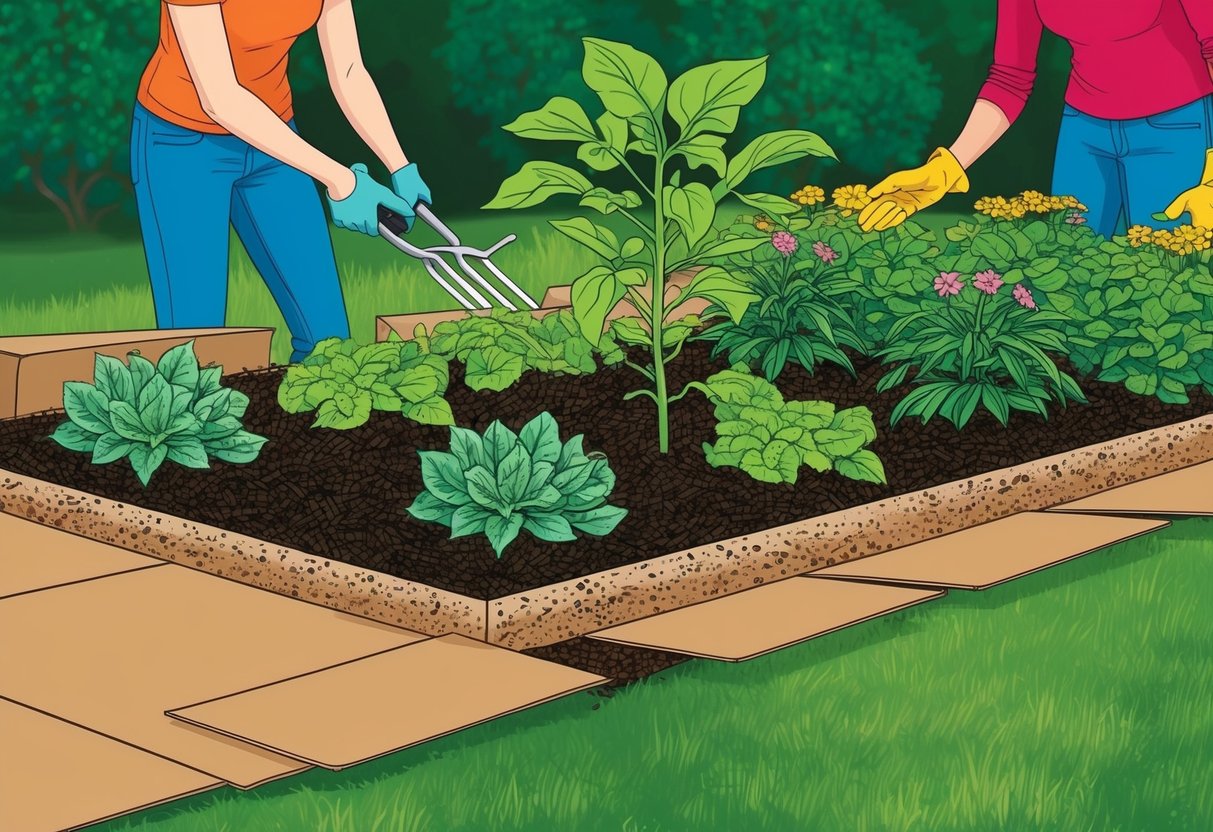
Integrating Soil Life and Structure
No-dig gardening enhances the natural ecosystem in the soil by supporting beneficial organisms that boost fertility, structure, and plant resilience. Organic mulches and compost feed earthworms, microorganisms, and fungi without disturbing their habitat.
These organisms thrive and improve the soil’s physical and biological health.
Encouraging Earthworms and Microorganisms
Earthworms are a key indicator of fertile soil. They burrow through the ground, breaking down organic matter and enhancing aeration, which means roots can access more air and moisture.
Their castings enrich the soil with nutrients, making them more available to plants. No-dig gardening encourages earthworms by leaving soil undisturbed and by applying layers of organic matter such as compost, mulches, or manure.
These layers act as ongoing food sources for worms and soil microorganisms, which accelerate decomposition and nutrient cycling. Common microorganisms include bacteria, protozoa, and actinomycetes.
They work alongside earthworms to transform decomposing plant material into rich humus and to suppress soil-borne diseases. This contributes to a healthier soil ecosystem.
Role of Fungi and Bacteria
Soil fungi, such as mycorrhizae, form beneficial relationships with plant roots. These fungi extend root systems and improve water and nutrient uptake, especially phosphorus.
Mycorrhizal associations, which develop best in undisturbed soils, are crucial for robust plant growth and resistance to drought. Bacteria play a different but equally vital role in soil health.
They decompose organic matter, fix atmospheric nitrogen, and release nutrients for plant use. In no-dig gardens, bacterial communities flourish in the rich, moist organic layers on the surface.
Mulching, as practiced in no dig gardens, helps maintain the temperature and moisture level that bacteria and fungi need to thrive.
Improving Soil Structure
Maintaining good soil structure ensures plant roots have the right balance of air, water, and nutrients. No-dig methods prevent compaction, preserve natural pore networks, and protect soil aggregation, which is the clumping of soil particles that improves water infiltration and storage.
Organic matter from compost and mulches supports this structure by attracting and feeding soil organisms that produce sticky substances to bond soil particles together. Healthy, undisturbed soil is home to a complex ecosystem supporting plant growth with minimal effort.
Over time, this leads to less run-off, improved root penetration, and stronger, healthier plants.
Choosing and Planting Crops
Selecting the right crops, preparing seeds, and using specific planting techniques in no-dig beds all help maximize yields and support healthy soil. Varieties such as tomatoes, onions, leafy greens, beans, herbs, berries, and fruit can thrive with no-dig practices while also improving biodiversity and resilience.
Selecting Seeds and Seedlings
When choosing seeds for a no-dig garden, prioritize varieties adapted to local climate and growing conditions. Heirloom and open-pollinated seeds are often favored for diversity and taste.
Disease-resistant types reduce the need for chemicals and enhance sustainability. Transplants and seedlings should have strong root systems and healthy foliage.
Avoid any plants with discoloration or wilting, as these could bring pests or diseases into the garden. Direct seeding is suitable for quick-growing crops, while seedlings are preferred for slow starters like tomatoes and peppers.
Local nurseries and reputable seed companies can provide seeds with higher germination rates and disease screening. For growing edible plants, non-GMO and organic-labelled seeds are often chosen by those aiming for chemical-free harvests.
Seeding Techniques for No-Dig Beds
No-dig gardening relies on layering organic matter like compost over undisturbed soil, so traditional tilling is avoided. For direct seeding, create a shallow trench or furrow in the compost using a hand tool, and sow seeds at the recommended spacing and depth.
Cover gently with fine compost rather than soil. Water seeds immediately after planting to encourage soil contact.
Mulch can be applied lightly over the seeded row to retain moisture and suppress weeds, but ensure emerging seedlings can break through. Transplants can be planted by making a hole through the compost and into the soil below, then firming around the roots.
Succession planting is widely used to maximize space and harvests, especially for salad greens, beans, and herbs. This means planting new seeds every couple of weeks for a continuous supply.
Popular Plants: Tomatoes, Onions, Greens, Beans and Herbs
Tomatoes thrive in the rich, loose compost of a no-dig bed. Plant sturdy seedlings deeply, removing lower leaves to encourage strong root growth.
Staking or caging supports tomatoes as they grow. Choose disease-resistant varieties and rotate locations each year to avoid soil-borne issues.
Onions grow best from sets or transplants in no-dig systems. They have shallow roots, so keep mulch around the bulbs to retain moisture but avoid direct contact with stems to prevent rot.
For greens such as lettuce and spinach, successive sowings keep harvests coming—scatter or row plant and harvest outer leaves frequently. Beans benefit from the undisturbed soil structure in a no-dig bed; sow directly into compost and keep well-watered.
Herbs like basil, parsley, and cilantro appreciate moisture retention and minimal disturbance. Group herbs by water and sunlight needs for efficient care.
Growing Berries and Fruits
Berries and small fruits do well in no-dig beds due to deep mulching and improved soil biology. Strawberries can be planted on top of compost, with runners pinned down to propagate new plants.
Blueberries thrive in slightly acidic, organic-rich soil—add peat or pine needles as mulch if needed. Raspberries and blackberries can be set in rows, mulched thickly, and pruned annually for best yields.
Fruit bushes and trees benefit from a wide mulch ring that keeps roots moist and limits weeds. For ongoing health, refresh layers of mulch and compost each season to boost microbial activity and nutrient availability.
For a more in-depth breakdown of no-dig planting steps, see this step-by-step guide.